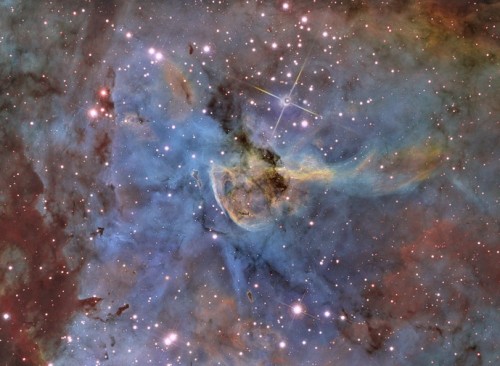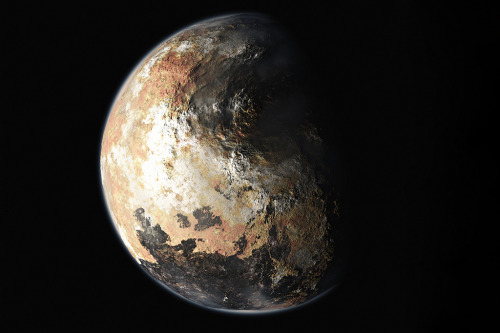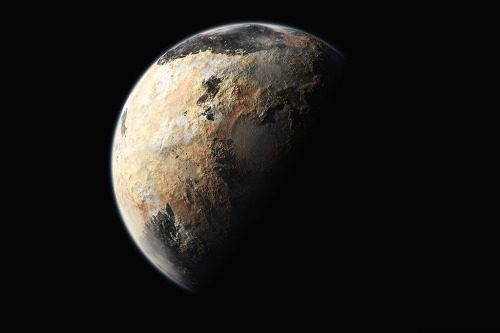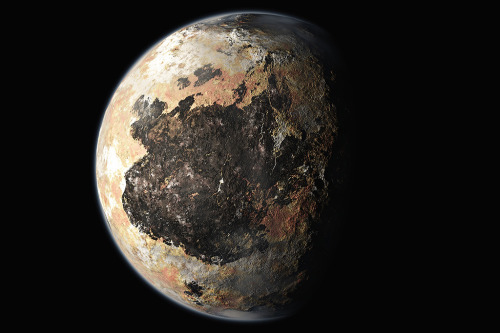M7: Open Star Cluster In Scorpius : M7 Is One Of The Most Prominent Open Clusters Of Stars On The Sky.

M7: Open Star Cluster in Scorpius : M7 is one of the most prominent open clusters of stars on the sky. The cluster, dominated by bright blue stars, can be seen with the naked eye in a dark sky in the tail of the constellation of the Scorpion . M7 contains about 100 stars in total, is about 200 million years old, spans 25 light-years across, and lies about 1000 light-years away. The featured wide-angle image was taken near the city of Belo Horizonte in Brazil. The M7 star cluster has been known since ancient times, being noted by Ptolemy in the year 130 AD. Also visible are a dark dust cloud on the lower right, and, in the background, literally millions of unrelated stars towards the Galactic center. via NASA
js
More Posts from Littlecadet-biguniverse and Others

NGC 3576, an emission nebula in the constellation of Carina 6,000 light years away. -image via paulhaese.net

The Soul Nebula.

47 Tucanae

Orion Nebula from HAWK-1 js

This beautiful supernova remnant is the product of a huge stellar explosion in our neighboring galaxy — the Small Magellanic Cloud (📷 : NASA)

Eta Carinae and Keyhole Nebula (NGC 3324), inside the Carina Nebula (NGC 3372)
Do telescopes actually take colorful photographs or are the pretty colorful photographs of galaxies that we know colored afterwards? If a human was floating through space, would space look colorful to them?
So some pictures are taken in different wavelengths to see different characteristics. (infrared wavelengths to see through thick gas and dust, xray wavelengths to see highly energized regions)
But, in the visible wavelengths you are seeing the colors. They’re just enhanced brighter than they might be.
For example, I took this picture of “the California Nebula” using a camera (Canon 60Da) attached to a telescope. This shows one exposure, and the background is red due to effects of the camera (which you subtract):

You take multiple exposures, combine them, subtract the background effects & adjust the color a little and get this…

-
 dhruvthestar26 liked this · 6 years ago
dhruvthestar26 liked this · 6 years ago -
 smallfryingpan liked this · 6 years ago
smallfryingpan liked this · 6 years ago -
 fanxiacg liked this · 6 years ago
fanxiacg liked this · 6 years ago -
 burnurcity liked this · 6 years ago
burnurcity liked this · 6 years ago -
 speedrunner-fuchs-wulf liked this · 6 years ago
speedrunner-fuchs-wulf liked this · 6 years ago -
 princesspuresarahk liked this · 6 years ago
princesspuresarahk liked this · 6 years ago -
 melisa-may-taylor72 liked this · 6 years ago
melisa-may-taylor72 liked this · 6 years ago -
 hushed-muses reblogged this · 6 years ago
hushed-muses reblogged this · 6 years ago -
 ooh-oooh liked this · 6 years ago
ooh-oooh liked this · 6 years ago -
 royalragnar liked this · 6 years ago
royalragnar liked this · 6 years ago -
 sirikenobilegends liked this · 6 years ago
sirikenobilegends liked this · 6 years ago -
 sirikenobilegends reblogged this · 6 years ago
sirikenobilegends reblogged this · 6 years ago -
 mohammedmuhit liked this · 6 years ago
mohammedmuhit liked this · 6 years ago -
 ausevor reblogged this · 6 years ago
ausevor reblogged this · 6 years ago -
 ausevor liked this · 6 years ago
ausevor liked this · 6 years ago -
 thefuckword-deactivated1637 liked this · 6 years ago
thefuckword-deactivated1637 liked this · 6 years ago -
 nerdycashheroshepherd liked this · 6 years ago
nerdycashheroshepherd liked this · 6 years ago -
 metalzoic liked this · 6 years ago
metalzoic liked this · 6 years ago -
 thedoctorsawkwardhufflepuff liked this · 6 years ago
thedoctorsawkwardhufflepuff liked this · 6 years ago -
 myerasalome liked this · 6 years ago
myerasalome liked this · 6 years ago -
 nogthegingerninja liked this · 6 years ago
nogthegingerninja liked this · 6 years ago -
 thatsnotyourpurse liked this · 6 years ago
thatsnotyourpurse liked this · 6 years ago -
 newyorksfinest liked this · 6 years ago
newyorksfinest liked this · 6 years ago -
 your-night-storyteller liked this · 6 years ago
your-night-storyteller liked this · 6 years ago -
 deliriousinfliction reblogged this · 8 years ago
deliriousinfliction reblogged this · 8 years ago -
 wheatbee reblogged this · 8 years ago
wheatbee reblogged this · 8 years ago -
 krissalus reblogged this · 8 years ago
krissalus reblogged this · 8 years ago -
 brettthehumanboy reblogged this · 8 years ago
brettthehumanboy reblogged this · 8 years ago -
 justacuriousspeck reblogged this · 8 years ago
justacuriousspeck reblogged this · 8 years ago -
 travelling-through-time-space reblogged this · 8 years ago
travelling-through-time-space reblogged this · 8 years ago -
 asterialsapphire reblogged this · 8 years ago
asterialsapphire reblogged this · 8 years ago -
 sacredsymbol821 reblogged this · 8 years ago
sacredsymbol821 reblogged this · 8 years ago -
 t-i-m-i-n-g reblogged this · 8 years ago
t-i-m-i-n-g reblogged this · 8 years ago -
 emzees reblogged this · 8 years ago
emzees reblogged this · 8 years ago -
 importantkryptonitemagazine liked this · 8 years ago
importantkryptonitemagazine liked this · 8 years ago -
 uchuubou liked this · 8 years ago
uchuubou liked this · 8 years ago -
 lettre-du-vide reblogged this · 8 years ago
lettre-du-vide reblogged this · 8 years ago -
 hannahleedleedleelee liked this · 8 years ago
hannahleedleedleelee liked this · 8 years ago -
 thestorminheaven reblogged this · 8 years ago
thestorminheaven reblogged this · 8 years ago -
 dun-look-up liked this · 8 years ago
dun-look-up liked this · 8 years ago
GREETINGS FROM EARTH! Welcome to my space blog! Let's explore the stars together!!!
144 posts





